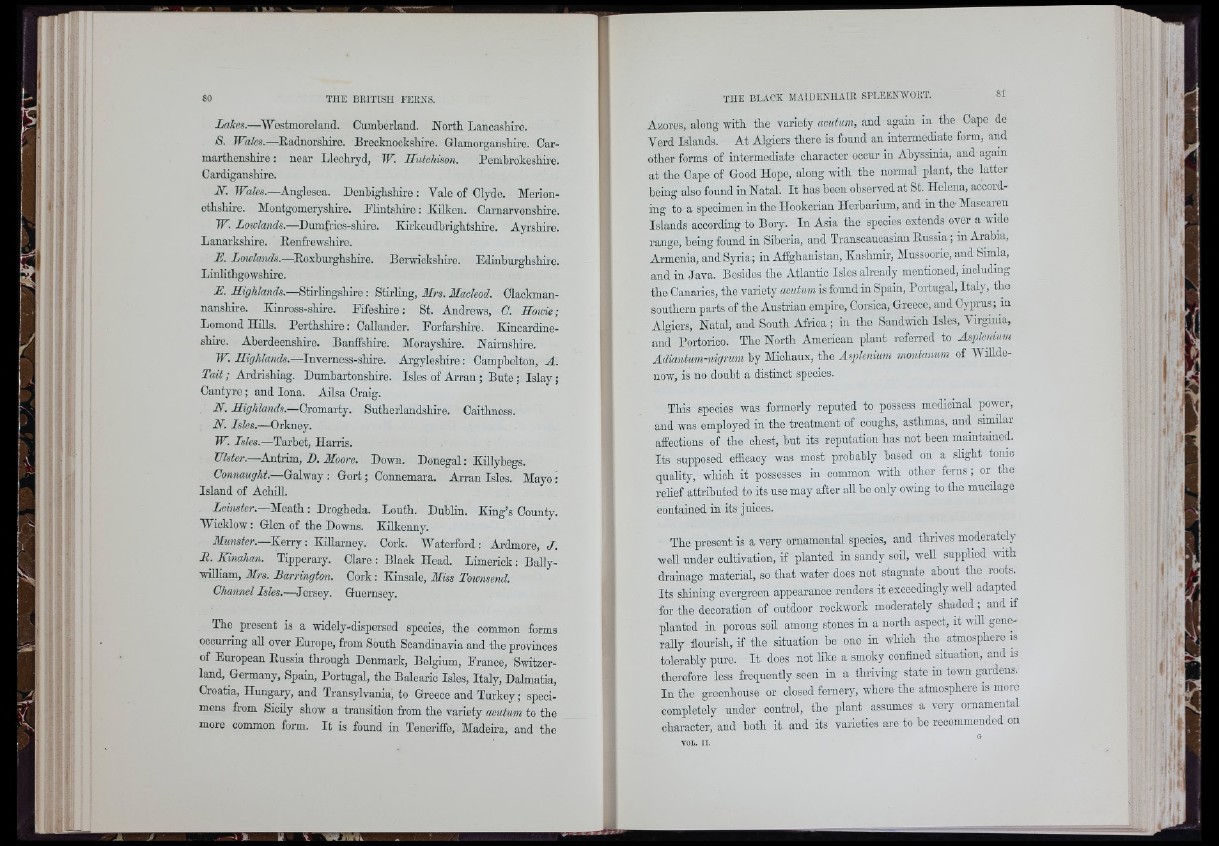
Lakes.—Westmoreland. Cumberland. North Lancashire.
8. Wales.—Radnorshire. Brecknockshire. Glamorganshire. Carmarthenshire
: near Lloohi’yd, W. Hutchison. Pembrokeshire.
Cardiganshire.
N. Wales.—Anglesea. Denbighshire : Vale of Clyde. Merionethshire.
Montgomeryshire. Flintshire: Küken. Carnarvonshire.
W. Lowlands.—Dumfrios-shii-e. Kirkcudbrightshire. Ayrshire.
Lanarkshire. Renfrewshire.
B. Lowlands.—Roxburghshire. Berwickshire. Edinburghshire.
Linlithgowshire.
E. Highlands.—Stirlingshire: Stirling, Mrs. Macleod. Clackmannanshire.
Kinross-shire. Fifeshire: St. Andrews, C. Howie;
Lomond HiUs. Perthshire: Callander. Forfarshire. Kincardineshire.
Aberdeenshh-e. Banffshire. Morayshire. Nairnshire.
W. Highlands.—Inverness-shire. Argyleshire: Campbolton, A.
Ta it; Ardrishiag. Dumbartonshire. Isles of Arran ; Bute ; Islay;
Cantyro; and Iona. Ailsa Craig.
N. Highlands.—Cromaxiy. Sutherlandshire. Caithness.
N. Isles.—Orkney.
W. Isles.—Tarbet, Harris.
Ulster.—Antrim, D. Moore. Down. Donegal: Külybegs.
Connaught.— (falway : Gort; Connemara. Arran Isles. Mayo:
Island of Achill.
Leinster.—Meath. : Drogheda. Louth. Dublin. King’s County.
Wicklow: Glen of the Downs. Kükenny.
Munster.—Kerry ■. Külamey. Cork. Waterford: Ardmore, J.
R. Kinahan. Tipperary. Clare : Black Head. Limerick: Bally-
wüliam, Mrs. Barrington. Cork: Kinsale, Miss Townsend.
Channel Isles.—Jersey. Guernsey.
The present is a widely-dispersed species, the common forms
occurring aU over Europe, from South Scandinavia and the provinces
of European Russia through Denmark, Belgium, France, Switzerland,
Germany, Spain, Portugal, the Balearic Isles, Italy, Dalmatia,
Croatia, Hungary, and Transylvania, to Greece and Turkey; specimens
from Sicüy show a transition from tho variety acutum to the
more common form. It is found in Tenoriffe, Madeira, and the
Azores, along with the variety acutum, and again in the Cape de
Vord Islands. At Algiers there is found an intermediate form, aud
other forms of intermediate oharaotcr occur in Abyssinia, and again
at tho Cape of Good Hopo, along with the normal plant, tho latter
being also found in Natal. It has been obsorvod at St. Helena, according
to a specimen in tho Hookerian Herbarium, and in tbe Mascaren
Islands according to Bory. In Asia the species extends over a wide
range, being found in Siberia, and Transcaucasian Russia ; in Arabia,
Armenia, andSyi’ia; in Affghanistan, Kashmir, Mussooiie, and Simla,
and in Java. Besides the Atlantic Isles already mentioned, including
the Canaries, the variety acutum is found in Spain, Portugal, Italy, the
southern parts of the Austrian empire, Corsica, Greece, and Cyprus ; in
Algiers, Natal, and South Africa ; in the Sandwich Isles, Virginia,
and Portorico. The North American plant referred to Asplemum
Adiantum-nigrum by Michaux, the Asplenium montanum of Wülde-
now, is no doubt a distinct species.
This species was formerly reputed to possess medicinal power,
and was employed in the treatment of coughs, asthmas, and similar
affections of the chest, but its reputation has not been mamtamed.
Its supposed efficacy was most probably based on a slight tonic
quality, which it possesses in common with other ferns ; or the
relief attributed to its use may after all be only owing to the mucüage
contained in its juices.
The present is a very ornamental species, and thrives moderately
weU under cultivation, if planted in sandy soil, weU supplied ivith
drainage material, so that water does not stagnate about tbe roots.
Its shining evergreen appearance renders it exceedingly well adapted
for the decoration of outdoor rockwork moderately shaded ; and if
planted in porous soü among stones in a north aspect, it wül genc-
raUy flourish, if the situation be one in which the atmosphere is
tolerably pure. It does not like a smoky confined situation, and is
therefore less frequently scon in a thriving state in town gardens.
In the greenhouse or closed fernery, whore tho atmosphere is more
completely under control, tho plant assumes a very ornamental
character, and both it and its varieties are to be recommended on